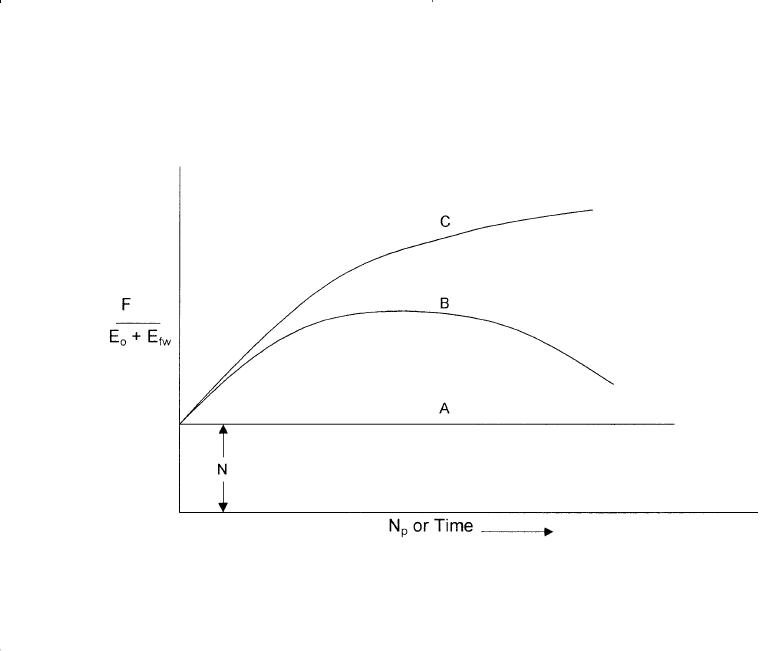Tarek Ahmed. Reservoir engineering handbook
Подождите немного. Документ загружается.


Example 11-1
A combination-drive reservoir contains 10 MMSTB of oil initially in
place. The ratio of the original gas-cap volume to the original oil volume,
i.e., m, is estimated as 0.25. The initial reservoir pressure is 3000 psia at
150°F. The reservoir produced 1 MMSTB of oil, 1100 MMscf of 0.8 spe-
cific gravity gas, and 50,000 STB of water by the time the reservoir pres-
sure dropped to 2800 psi. The following PVT is available:
3000 psi 2800 psi
B
o
, bbl/STB 1.58 1.48
R
s
, scf/STB 1040 850
B
g
, bbl/scf 0.00080 0.00092
B
t
, bbl/STB 1.58 1.655
B
w
, bbl/STB 1.000 1.000
The following data is also available:
S
wi
= 0.20 c
w
= 1.5 × 10
−6
psi
−1
c
f
= 1 × 10
−6
psi
−1
Calculate:
a. Cumulative water influx
b. Net water influx
c. Primary driving indexes at 2800 psi
Solution
Because the reservoir contains a gas cap, the rock and fluid expansion
can be neglected, i.e., set c
f
and c
w
= 0. For illustration purposes, howev-
er, the rock and fluid expansion term will be included in the calculations.
Part A. Cumulative water influx
Step 1. Calculate cumulative gas-oil ratio R
p
:
R scf STB
p
=
×
×
=
1100 10
110
1100
6
6
/
748 Reservoir Engineering Handbook
Reservoir Eng Hndbk Ch 11 2001-10-25 15:59 Page 748

Step 2. Arrange Equation 11-17 to solve for W
e
:
Neglecting the rock and fluid expansion term, the cumulative water
influx is 417,700 bbl.
Part B. Net water influx
Net water influx = W
e
− W
p
B
w
= 411,281 − 50,000 = 361,281 bbl
Part C. Primary recovery indexes
Step 1. Calculate the parameter A by using Equation 11-19:
A = 10
6
[1.655 + (1100 − 1040) 0.00092] = 1,710,000
Step 2. Calculate DDI, SDI, and WDI by applying Equations 11-21
through 11-23, respectively:
SDI =
×−
=
10 10 0 25 1 58 0 00092 0 0008 0 0008
1 710 000
0 3465
6
(. )(. )(. . )/ .
,,
.
DDI =
×−
=
10 10 1 655 1 58
1 710 000
0 4385
6
(. . )
,,
.
WNB RRB NBB mB
B
B
Bm
Sc c
S
pWB
W
e p t p si g g ti ti
g
gi
ti
wi w f
wi
pwp
e
=+− −−+ −
++
+
−
+
=+−
−−+
[( )]( )
()
[. ( ) . ]
(. . )
1
1
1
10 1 655 1100 1040 0 00092
10 1 655 1 58 0
6
7
∆
.. ( . )
.
.
.( .)
.(. )
.
(),
,
25 1 58
0 00092
0 00080
1
158 1 025
02 15 10
102
3000 2800 50 000
411 281
6
−
++
×
−
−
+
=
−
bbl
Oil Recovery Mechanisms and the Material Balance Equation 749
Reservoir Eng Hndbk Ch 11 2001-10-25 15:59 Page 749

EDI = 1 − 0.4385 − 0.3465 − 0.2112 = 0.0038
where EDI is termed the expansion-drive index.
These calculations show that the 43.85% of the recovery was obtained
by depletion drive, 34.65% by gas-cap drive, 21.12% by water drive, and
only 0.38% by connate water and rock expansion. The results suggest
that the expansion-drive index (EDI) term can be neglected in the pres-
ence of a gas cap or when the reservoir pressure drops below the bubble-
point pressure. In high pore volume compressibility reservoirs, such as
chalks and unconsolidated sands, however, the energy contribution of the
rock and water expansion cannot be ignored even at high gas saturations.
Example 11-2
The Big Butte field is a combination-drive reservoir. The current reser-
voir pressure is estimated at 2500 psi. The reservoir production data and
PVT information are given below:
Initial reservoir Current reservoir
condition condition
p, psi 3000 2500
B
o
, bbl/STB 1.35 1.33
R
s
, scf/STB 600 500
N
p
, MMSTB 0 5
G
p
, MMMscf 5.5
B
w
, bbl/STB 1.00 1.00
W
e
, MMbbl 0 3
W
p
, MMbbl 0 0.2
B
g
, bbl/scf 0.0011 0.0015
c
f
, c
w
00
The following additional information is available:
Volume of bulk oil zone = 100,000 ac-ft
Volume of bulk gas zone = 20,000 ac-ft
Calculate the initial oil in place.
WDI =
−
=
411 281 50 000
1 710 000
0 2112
,,
,,
.
750 Reservoir Engineering Handbook
Reservoir Eng Hndbk Ch 11 2001-10-25 15:59 Page 750

Solution
Step 1. Assuming the same porosity and connate water for the oil and gas
zones, calculate m:
Step 2. Calculate the cumulative gas-oil ratio R
p
:
Step 3. Solve for the initial oil-in-place by applying Equation 11-15:
Basic Assumptions in the MBE
The material balance equation calculation is based on changes in reser-
voir conditions over discrete periods of time during the production histo-
ry. The calculation is most vulnerable to many of its underlying assump-
tions early in the depletion sequence when fluid movements are limited
and pressure changes are small. Uneven depletion and partial reservoir
development compound the accuracy problem.
The basic assumptions in the material balance equation (MBE) are as
follows:
• Constant temperature. Pressure-volume changes in the reservoir are
assumed to occur without any temperature changes. If any temperature
changes occur, they are usually sufficiently small to be ignored without
significant error.
• Pressure equilibrium. All parts of the reservoir have the same pressure,
and fluid properties are therefore constant throughout. Minor variations in
the vicinity of the well bores may usually be ignored. Substantial pressure
variation across the reservoir may cause excessive calculation error.
N
MMSTB
=
×+− −×−×
−+− + −
=
5 10 1 33 1100 500 0 0015 3 10 0 2 10
1 35 1 33 600 500 0 0015 0 2 1 35
0 0015
0 0011
1
31 14
666
[. ( ) . ] ( . )
(. . ) ( ) . (.)(. )
.
.
.
R scf STB
p
=
×
×
=
55 10
510
1100
9
6
.
/
m ==
20 000
100 000
02
,
,
.
Oil Recovery Mechanisms and the Material Balance Equation 751
Reservoir Eng Hndbk Ch 11 2001-10-25 15:59 Page 751

It is assumed that the PVT samples or data sets represent the actual
fluid compositions and that reliable and representative laboratory proce-
dures have been used. Notably, the vast majority of material balances
assume that differential depletion data represent reservoir flow and that
separator flash data may be used to correct for the wellbore transition to
surface conditions. Such “black oil” PVT treatments relate volume
changes to temperature and pressure only. They lose validity in cases of
volatile oil or gas condensate reservoirs where compositions are also
important. Special laboratory procedures may be used to improve PVT
data for volatile fluid situations.
Constant reservoir volume. Reservoir volume is assumed to be con-
stant except for those conditions of rock and water expansion or water
influx that are specifically considered in the equation. The formation is
considered to be sufficiently competent that no significant volume
change will occur through movement or reworking of the formation due
to overburden pressure as the internal reservoir pressure is reduced. The
constant volume assumption is also related to an area of interest to which
the equation is applied. If the focus is on some part of a reservoir system,
except for specific exterior flow terms it is assumed that the particular
portion is encased in no-flow boundaries.
Reliable production data. All production data should be recorded
with respect to the same time period. If possible, gas-cap- and solution-
gas production records should be maintained separately.
Gas and oil gravity measurements should be recorded in conjunction
with the fluid volume data. Some reservoirs require a more detailed
analysis and that the material balance be solved for volumetric segments.
The produced fluid gravities will aid in the selection of the volumetric
segments and also in the averaging of fluid properties. There are essen-
tially three types of production data that must be recorded in order to use
the MBE in performing reliable reservoir calculations. These are:
• Oil-production data, even for non-interest properties, which can usual-
ly be obtained from various sources and is usually fairly reliable.
• Gas-production data, which are becoming more available and reliable
as the market value of this commodity increases; unfortunately, these
data will often be more questionable where gas is flared.
• The water-production term, which need represent only the net with-
drawals of water; therefore, where subsurface disposal of produced
brine is to the same source formation, most of the error due to poor
data will be eliminated.
752 Reservoir Engineering Handbook
Reservoir Eng Hndbk Ch 11 2001-10-25 15:59 Page 752

The MBE as an Equation of a Straight Line
An insight into the general MBE, i.e., Equation 11-15, may be gained
by considering the physical significance of the following groups of terms
of which it is comprised:
• N
p
[B
o
+ (R
p
− R
s
) B
g
] Represents the reservoir volume of cumula-
tive oil and gas produced.
• [W
e
− W
p
B
w
] Refers to the net water influx that is retained
in the reservoir.
• [G
inj
B
ginj
+ W
inj
B
w
] This pressure maintenance term represents
cumulative fluid injection in the reservoir.
• [m B
oi
(B
g
/B
gi
− 1)] Represents the net expansion of the gas cap
that occurs with the production of N
p
stock-
tank barrels of oil (as expressed in bbl/STB
of original oil in place).
There are essentially three unknowns in Equation 11-15:
a. The original oil in place N
b. The cumulative water influx W
e
c. The original size of the gas cap as compared to the oil zone size m
In developing a methodology for determining the above three
unknowns, Havlena and Odeh (1963) expressed Equation 11-15 in the
following form:
Havlena and Odeh further expressed Equation 11-24 in a more con-
densed form as:
F = N [E
o
+ m E
g
+ E
f,w
] + (W
e
+ W
inj
B
w
+ G
inj
B
ginj
)
Assuming, for the purpose of simplicity, that no pressure maintenance
by gas or water injection is being considered, the above relationship can
be further simplified and written as:
F = N [E
o
+ m E
g
+ E
f,w
] + W
e
(11-25)
N [B (R R )B ] W B N[(B B ) (R R )B ]
mNB
B
B
1
N (1 + m)B
cS +c
1+S
p
W W B G B (11 - 24)
p o p s g p w o oi si s g
oi
g
gi
oi
wwi f
wi
e inj w inj ginj
+− + = −+−
+−
+
+
++
∆
Oil Recovery Mechanisms and the Material Balance Equation 753
Reservoir Eng Hndbk Ch 11 2001-10-25 15:59 Page 753

In which the terms F, E
o
, E
g
, and E
f,w
are defined by the following
relationships:
• F represents the underground withdrawal and given by:
F = N
p
[B
o
+ (R
p
− R
s
) B
g
] + W
p
B
w
(11-26)
In terms of the two-phase formation volume factor B
t
, the under-
ground withdrawal F can be written as:
F = N
p
[B
t
+ (R
p
− R
si
) B
g
] + W
p
B
w
(11-27)
• E
o
describes the expansion of oil and its originally dissolved gas and is
expressed in terms of the oil formation volume factor as:
E
o
= (B
o
− B
oi
) + (R
si
− R
s
) B
g
(11-28)
Or equivalently, in terms of B
t
:
E
o
= B
t
− B
ti
(11-29)
• E
g
is the term describing the expansion of the gas-cap gas and is
defined by the following expression:
E
g
= B
oi
[(B
g
/B
gi
) − 1] (11-30)
In terms of the two-phase formation volume factor B
t
, essentially B
ti
=
B
oi
or:
E
g
= B
ti
[(B
g
/B
gi
) − 1]
• E
f,w
represents the expansion of the initial water and the reduction in
the pore volume and is given by:
Havlena and Odeh examined several cases of varying reservoir types
with Equation 11-25 and pointed out that the relationship can be
rearranged into the form of a straight line. For example, in the case of a
reservoir which has no initial gas cap (i.e., m = 0) or water influx (i.e.,
W
e
= 0), and negligible formation and water compressibilities (i.e., c
f
and
c
w
= 0); Equation 11-25 reduces to:
F = N E
o
EmB
cS c
S
p
fw oi
wwi f
wi
,
()=+
+
−
1
1
∆ (11- 31)
754 Reservoir Engineering Handbook
Reservoir Eng Hndbk Ch 11 2001-10-25 15:59 Page 754

The above expression suggests that a plot of the parameter F as a func-
tion of the oil expansion parameter E
o
would yield a straight line with a
slope N and intercept equal to zero.
The Straight-Line Solution Method to the MBE
The straight-line solution method requires the plotting of a variable
group versus another variable group, with the variable group selection
depending on the mechanism of production under which the reservoir is
producing. The most important aspect of this method of solution is that it
attaches significance the sequence of the plotted points, the direction in
which they plot, and to the shape of the resulting plot.
The significance of the straight-line approach is that the sequence of
plotting is important and if the plotted data deviates from this straight
line there is some reason for it. This significant observation will provide
the engineer with valuable information that can be used in determining
the following unknowns:
• Initial oil in place N
• Size of the gas cap m
• Water influx W
e
• Driving mechanism
The remainder of this chapter is devoted to illustrations of the use of
the straight-line solution method in determining N, m, and W
e
for differ-
ent reservoir mechanisms.
Case 1. Volumetric Undersaturated-Oil Reservoirs
Assuming no water or gas injection, the linear form of the MBE as
expressed by Equation 11-25 can be written as:
F = N [E
o
+ m E
g
+ E
f,w
] + W
e
(11-32)
Several terms in the above relationship may disappear when imposing
the conditions associated with the assumed reservoir driving mechanism.
For a volumetric and undersaturated reservoir, the conditions associated
with driving mechanism are:
• W
e
= 0, since the reservoir is volumetric
• m = 0, since the reservoir is undersaturated
• R
s
= R
si
= R
p
, since all produced gas is dissolved in the oil
Oil Recovery Mechanisms and the Material Balance Equation 755
Reservoir Eng Hndbk Ch 11 2001-10-25 15:59 Page 755

Applying the above conditions on Equation 11-32 gives:
F = N (E
o
+ E
f,w
) (11-33)
or
where N = initial oil in place, STB
F = N
p
B
o
+ W
p
B
w
(11 - 35)
E
o
= B
o
− B
oi
(11 - 36)
∆p = p
i
− p
–
r
p
i
= initial reservoir pressure
p
–
r
= volumetric average reservoir pressure
When a new field is discovered, one of the first tasks of the reservoir
engineer is to determine if the reservoir can be classified as a volumetric
reservoir, i.e., W
e
= 0. The classical approach of addressing this problem
is to assemble all the necessary data (i.e., production, pressure, and PVT)
that are required to evaluate the right-hand side of Equation 11-36. The
term F/(E
o
+ E
f,w
) for each pressure and time observation is plotted versus
cumulative production N
p
or time, as shown in Figure 11-16. Dake (1994)
suggests that such a plot can assume two various shapes, which are:
• All the calculated points of F/(E
o
+ E
f,w
) lie on a horizontal straight line
(see Line A in Figure 11-16). Line A in the plot implies that the reser-
voir can be classified as a volumetric reservoir. This defines a purely
depletion-drive reservoir whose energy derives solely from the expan-
sion of the rock, connate water, and the oil. Furthermore, the ordinate
value of the plateau determines the initial oil in place N.
• Alternately, the calculated values of the term F/(E
o
+ E
f,w
) rise, as illus-
trated by the curves B and C, indicating that the reservoir has been ener-
gized by water influx, abnormal pore compaction, or a combination of
EB
cS c
S
p
fw oi
ww f
wi
,
=
+
−
1
∆ (11- 37)
N
F
EE
ofw
=
+
,
(11- 34)
756 Reservoir Engineering Handbook
Reservoir Eng Hndbk Ch 11 2001-10-25 15:59 Page 756

these two. Curve C in Figure 11-16 might be for a strong water-drive
field in which the aquifer is displacing an infinite acting behavior, where-
as B represents an aquifer whose outer boundary has been felt and the
aquifer is depleting in unison with the reservoir itself. The downward
trend in points on curve B as time progresses denotes the diminishing
degree of energizing by the aquifer. Dake (1994) points out that in water-
drive reservoirs, the shape of the curve, i.e., F/(E
o
+ E
f,w
) vs. time, is
highly rate dependent. For instance, if the reservoir is producing at higher
rate than the water-influx rate, the calculated values of F/(E
o
+ E
f,w
) will
dip downward revealing a lack of energizing by the aquifer, whereas, if
the rate is decreased, the reverse happens and the points are elevated.
Similarly, Equation 11-33 could be used to verify the characteristic of
the reservoir-driving mechanism and to determine the initial oil in place. A
plot of the underground withdrawal F versus the expansion term (E
o
+ E
f,w
)
should result in a straight line going through the origin with N being the
slope. It should be noted that the origin is a “must” point; thus, one has a
fixed point to guide the straight-line plot (as shown in Figure 11-17).
Oil Recovery Mechanisms and the Material Balance Equation 757
Figure 11-16. Classification of the reservoir.
Reservoir Eng Hndbk Ch 11 2001-10-25 15:59 Page 757
